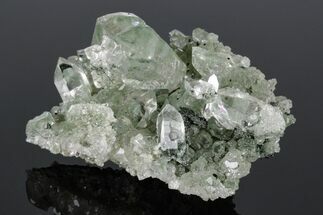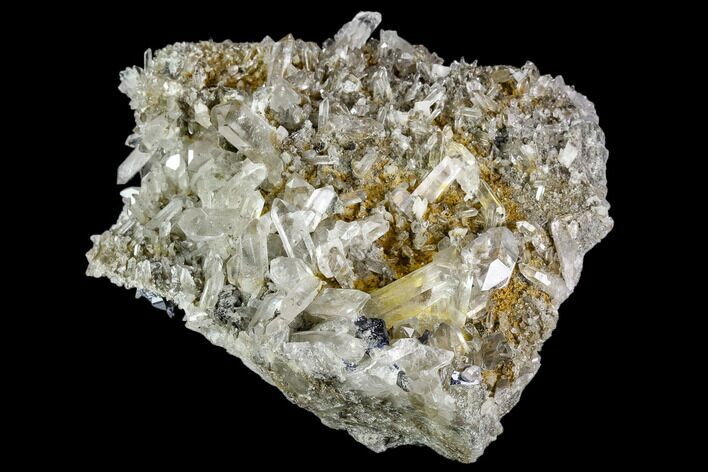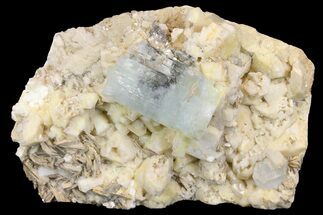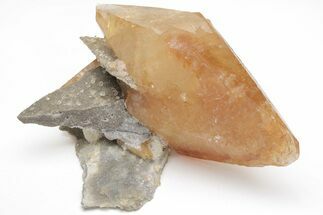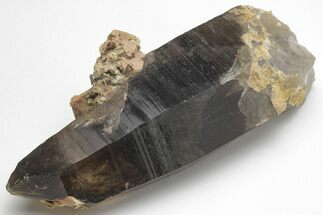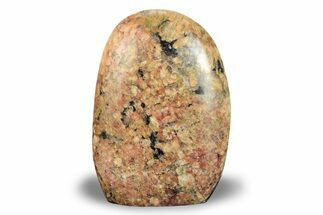This Specimen has been sold.
4.4" Anatase Crystals, Quartz and Adularia - Norway
This incredible specimen contains an association of several metallic, twinned anatase crystals, quartz crystals and white adularia (variety of orthoclase). The crystals formed from a schist matrix that was collected from Hardangervidda, Norway. The largest anatase crystal on this specimen measures in at .35" long.
About Anatase
Anatase is a mineral composed of titanium dioxide that typically forms dipyramidal crystals, although variations can occur with mineral clumping. Four-pointed, X-shaped anatase crystals, while rare, have been found and are known as "X-shaped penetration twins". Horizontal striations can be seen across most anatase mineral faces and most crystals end in points, or with variations of flattening on each end. It can be found in a variety of colors, from browns and reds to greens and pinks, and can be colorless in very rare cases. However, it is most commonly black or other very dark colors due to impurities.
Anatase is a mineral composed of titanium dioxide that typically forms dipyramidal crystals, although variations can occur with mineral clumping. Four-pointed, X-shaped anatase crystals, while rare, have been found and are known as "X-shaped penetration twins". Horizontal striations can be seen across most anatase mineral faces and most crystals end in points, or with variations of flattening on each end. It can be found in a variety of colors, from browns and reds to greens and pinks, and can be colorless in very rare cases. However, it is most commonly black or other very dark colors due to impurities.
Adularia is a variety of feldspar that had the chemical formula KAlSi3O8. It is found most often as colorless to white aggregations within metamorphic rock, usually within cavities of crystalline schists. Adularia crystals are commonly twinned, glassy and prismatic in structure, and in some cases they display opalescent characteristics. Adularia is very similar to orthoclase, even bearing the same chemical formula, but it has a different crystalline structure and reacts differently to various tests. Its name comes from its type locality: the Adula Massif in the Alps of south-central Switzerland.
About Quartz
Quartz is the name given to silicon dioxide (SiO2) and is the second most abundant mineral in the Earth's crust. Quartz crystals generally grow in silica-rich environments--usually igneous rocks or hydrothermal environments like geothermal waters--at temperatures between 100°C and 450°C, and usually under very high pressure. In either case, crystals will precipitate as temperatures cool, just as ice gradually forms when water freezes. Quartz veins are formed when open fissures are filled with hot water during the closing stages of mountain formation: these veins can be hundreds of millions of years old.
Quartz is the name given to silicon dioxide (SiO2) and is the second most abundant mineral in the Earth's crust. Quartz crystals generally grow in silica-rich environments--usually igneous rocks or hydrothermal environments like geothermal waters--at temperatures between 100°C and 450°C, and usually under very high pressure. In either case, crystals will precipitate as temperatures cool, just as ice gradually forms when water freezes. Quartz veins are formed when open fissures are filled with hot water during the closing stages of mountain formation: these veins can be hundreds of millions of years old.
SPECIES
Anatase, Quartz & Orthoclase var. Adularia
LOCATION
Hardangervidda, Norway
SIZE
Entire specimen 4.4 x 3.7", .35" longest crystal
CATEGORY
ITEM
#111425
 Reviews
Reviews
